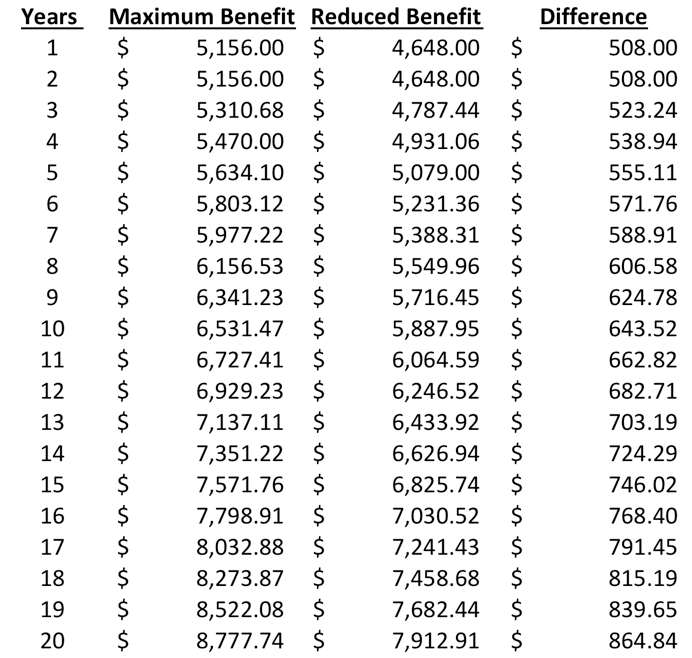Warning: This is a long post about the Missouri Public School Retirement System PSRS. If you have zero interest in the Missouri pension system PSRS, how it works, or the options you have then this post isn’t for you. But if you are within a few short years of retiring from the PSRS or have questions about your pension and want an independent, objective review – then you’re in the right place.
To clarify up front, I am in the financial services business and with that come heavy regulations about what I can and can’t say. So, to keep the regulators happy I am required to explain that while this review is independent, I am a financial advisor and some of the information I am providing as possible options for you to consider could result in obtaining my services. They just want you to know that by doing so, could result in me being compensated for my time and/or services. However, this review is clearly being made available to you at no charge without obligation to engage my services.
Why This PSRS Review Will Help You
I often get a lot of questions from blog readers, podcast listeners, and clients about the Public School Retirement System (PSRS). The top questions I get are the following:
- I have reached the Rule of 80 but how do I know which pension option to take?
- What is the Rule of 86 and what is a PLSO?
- Should I buy years and how can I afford to buy them?
In the past few years’ pensions have all but disappeared making the PSRS one of a handful of remaining defined benefit programs (DBP). Many employers have changed over to defined contribution plans (DCP), which shifts the responsibility for saving for retirement from the employer to the employee.
One of the reasons for this shift from DBP’s to DCP’s is the liability the employer has of providing a lifetime of benefits to a retiree and in some cases their spouse’s life when a spousal benefit is elected. According to Heritage.org[i], misaligned risks and incentives, poor pension management, an aging workforce and the recent financial crisis are all factors that have lead to pension estimates for future liabilities vulnerable to default. Sadly, this is under-reported and there’s a lot of misinformation out there about these vulnerabilities.
Missouri public school retirees doing research on their pension options has become increasingly difficult. When using Google to do research, for example, you often get search results that point directly to the PSRS or a media outlet selling subscriptions and advertising. Some of these sites are not really truly independent or helpful research.
This pension review is just the opposite. It is 100% independent, breaks down the good and bad, and uses fully disclosed research. The purpose is to help those thinking of retiring make a well-informed decision.
Your pension is just one component of your retirement plan. How prepared are you? Click here to find out with our exclusive Retirement Checklist.
What’s Covered in This Review
In this review I’ll be covering the following information on the Missouri Public School Retirement System for educators and administrators:
- How your pension is calculated
- What your pension options are
- Pension Lump Sum Option (PLSO)
- What to consider BEFORE making your election
- How to buy service years
What you’ll find is that like all pensions, the idea of having a guaranteed income in your retirement years is a good thing. However, there are things you need to understand about pensions that can put you into a situation that is irrevocable. It’s important you understand your options so you can determine for yourself which options are best suited for your situation.
For readers who have found my website for the first time and don’t know much about me, I am a financial planner. I work with many PSRS members who all at one time or another have asked the same questions about their pension. This independent review is to simply offer impartial and objective views to the most commonly asked questions I get.
The Missouri Public School Retirement System (PSRS) for Educators and Administrators
Most educators are familiar or have heard about their pension and know that it is a very generous program. A popular way people are being introduced to their benefits is either through the PSRS themselves or from financial advisors who come into school districts and conduct presentations offering pension or product information. Once the presentation is done they invite the attendees to visit for a free consultation/review of sorts.
I’ve done plenty of seminars over the years and feel they are a great way to educate/help people. I have observed though, that in recent years, more and more of the advisors doing seminars have become quite focused on product sales. There are plenty of great agents/advisors out there that only make suitable recommendations, but there are also some that aren’t always focused on their client’s best interest.
By doing this review I hope to be able to help PSRS retirees better understand their choices and help make smart educated decisions about their pension. So let’s dig in.
How Your PSRS Benefits Are Determined
The PSRS has a formula to calculate your benefits that is fairly straightforward. It is your Final Average Salary multiplied by your Years of Service multiplied by a Benefit Factor of 2.5%, which equals your Single Life Benefit.
To break this down for you, according to the PSRS website, your benefits are determined by the following:
- The 2.5% Benefit Factor which is set by law and is permanent.
- Final Average Salary is a monthly average of your three highest consecutive years of PSRS-covered salary (including employer-paid health, dental and vision insurance premiums).
- Years of Service includes the number of years of service you have earned, reinstated and purchased.
You are eligible for normal (full) retirement benefits calculated with a 2.5% benefit factor at:
- Age 60 with at least five years of service
- Any age with at least 30 years of service
- Rule of 80 when the sum of your age plus your years of service equals 80 or more
If you work three years past normal retirement, you can choose a one-time, Partial Lump Sum Option (PLSO) payment at retirement with reduced lifetime benefits.
You are eligible for PLSO if you:
- Are at least age 63 with eight or more years of service
- Have 33 or more years of service
- Qualify for Rule of 86 (when your age plus your years of service equals 86 or more)
Your lifetime monthly benefit amount will be reduced if you take a PLSO payment. The reduction is based on the amount of the payment and your age at retirement.
Most, or all, of a PLSO payment, is considered taxable income by the IRS unless it is rolled over into an Individual Retirement Account (IRA)
This is from their website[ii] and is not tax or legal advice. I’m just reporting here, so know that PSRS can change the rules and the factors at any time.
For those who know me well, know that I’m a bit of a math junkie. So I wanted to really peel back the layers on this and get a better idea of just how it works and what a PSRS member might consider before making an election.
CLICK HERE TO LEARN A STRATEGY THAT WORKS TO SOLVE MANY OF THE ISSUES PSRS MEMBERS FACE
Warning: Extreme Math Geekery Ahead!
It is important to understand that a pension is simply a promise of future benefits, which by definition allows the rules of the savings plan to change or be discontinued at any time, leaving you vulnerable to things outside of your control.
If you consider that you have no control over the plan itself and that the trending trajectory of such plans is diminishing, it may be wise to seek ways to take advantage of your pension while moving as much into your control as possible.
This is how we are going to do this. Since there are essentially three considerations here that we will review, we will discuss these individually to avoid confusion.
- Your annuity options
- Your PSLO options
- Buying years
To stay consistent, we will assume throughout these points that you were born in 1953, have 33 years of service and have an average salary of $75,000 per year. (Example used as illustration only, not indicative of any particular situation, actual results will vary. This analysis is provided for informational purposes only and should not be construed as a recommendation. COLA rate used is for illustration only, actual rates will vary.)
Your Annuity Option
Before I walk through an example with you, it is important for you to understand all of your annuity options. According to the PSRS website[iii], at retirement, you choose from six different plans to direct the payment of your lifetime monthly service retirement benefits. These plans give you the flexibility to choose the appropriate level of financial protection for your loved ones after your death. You cannot change your benefit plan after your PSRS retirement date. No matter which benefit plan you choose, you will receive benefits for life.
The Single Life Benefit Plan
- Largest lifetime retiree benefit
- No monthly benefits for your beneficiary
- Any remaining contributions and interest at your death are paid to your beneficiary.
The Joint-and-Survivor Benefit Plans
The three Joint-and-Survivor benefit plans offer reduced lifetime retiree benefits with varying degrees of lifetime monthly benefit protection for your beneficiary after your death.
- Your lifetime benefits are reduced based on your age and the age of your beneficiary.
- Your beneficiary receives lifetime benefits after your death.
- You can choose beneficiary payments equal to 100%, 75% or 50% of your benefit.
- The greater the beneficiary percentage, the greater the reduction in your benefit.
- If your beneficiary dies before you, your benefit “pops up” to the larger Single Life amount.
- You can name only one person with a financial dependence on you as your Joint-and-Survivor beneficiary. A spouse, child or parent is automatically eligible.
- You can change your beneficiary only if you have named your spouse, your spouse dies or you divorce, and you subsequently remarry and designate your new spouse as beneficiary.
The Term-Certain Benefit Plans
- These plans provide financial protection for your beneficiary should you die within a limited period of time (or term) that begins at your retirement date.
- You can choose between a 60-month or a 120-month term plan.
- If you die during the term you selected, your beneficiary receives the remaining payments in the term. Beneficiary payments stop when the term ends.
- If you live longer than the term, your beneficiary receives no benefits from PSRS.
- Your monthly retirement benefit is reduced, but not as much as under the Joint-and-Survivor plans.
- You can name any person or legal entity as your Term-Certain beneficiary. You can change your beneficiary any time.
Now, on to the example…
In our example, your maximum benefit amount is $5,146 per month, while a reduced spousal benefit is $4,648 per month, with a difference of $498 per month. (We are using the single life payout and comparing it to the 100% joint and survivor benefit.) What this means is that in order for your spouse to continue to receive your pension payments after your death, you must give up $498 of your maximum pension amount each month.
Another component in this example is that your PSRS pension has a COLA (Cost of Living Adjustment) built in. According to the PSRS website, eligible service and disability retirees may receive cost-of-living adjustments (COLAs) on monthly benefits beginning the second January following their retirement date.
Current Missouri law states that COLAs cannot exceed 5% per year and the dollar amount of the COLAs in your lifetime cannot exceed 80% of your original monthly retirement benefit.
If you analyze the chart below and compare the maximum benefit to the reduced benefit, you will see the compounding effects of the COLA on the benefit. For this example I have assumed a COLA rate of 3%.
Over twenty years, the maximum benefit grows to a whopping $8,777.74 per month, while the reduced benefit grows to $7,912.91 per month. That is a monthly difference of $864.84 per month! Multiply this by twelve months and you find that the annual difference in payments in year twenty is $10,377.96. If you combine the difference of all twenty years, you will find that the amount you paid for the spousal benefit totals $159,208.43.
So what did we learn from this chart?
We learned that the price of extending a benefit to your spouse after you die is $159,208.43 over twenty years. Keep in mind that this assumes you die in the twentieth year. If you live longer, these benefits and costs continue to grow larger until you cap out when you reach the 80% rule. Of course, if you die sooner then the cost to provide the benefit may be less.
The $159,208.43 is essentially a premium you pay to the PSRS to cover your spouse if and when you die. If you are paying a cost/premium each year for someone to provide a benefit to your spouse when you die. One of the problems in this arrangement is the fact that this benefit is only transferable to your surviving spouse, which means that the benefits do not transfer to your heirs.
So let’s review what we know so far:
- The cost of the policy goes up each year since the COLA received on the maximum benefit is greater than what is received on the reduced benefit. The chasm between the two benefits continues to widen until the 80% rule is reached.
- When taking a reduced spousal benefit, the benefit continues to go down each year you and your spouse are alive, making the number of years the benefit may be received less each year that passes.
- You disinherit your family since the benefits are not transferable to your heirs.
In my experience, many retirees think the reduced benefit is the preferred choice to protect their spouse until they learn the cost that goes along with making that election. What I have found is that after an educator understands they can take their maximum benefit and purchase a life insurance policy outside of the pension system that will protect both their spouse and their heirs, they may decide to choose to take the maximum benefit.
CLICK HERE TO LEARN MORE ABOUT HOW LIFE INSURANCE WORKS
Keep in mind that that this takes careful planning and the use of a permanent form of life insurance contracts to make this work. You should be careful to only use experienced advisors when making these decisions.
Pension Lump Sum Option (PLSO)
According to the PSRS website, you can choose a lump-sum payment equal to 12, 24 or 36 times your Single Life benefit. Your lifetime monthly benefit amount is reduced to offset the PLSO payment you receive at retirement.
In other words, IF you qualify for a PLSO you can take in advance a portion of your monthly benefit in a single lump sum in exchange for a reduced monthly annuity payment.
Here is what this would look like:
$5,156 X 12 = $61,872 with a reduced monthly benefit of $4,723
-OR-
$5,156 X 24 = $123,744 with a reduced monthly benefit of $4,290
-OR-
$5,156 X 36 = $185,616 with a reduced monthly benefit of $3,858
The PSRS offers this as an option to reduce their exposure long term. If they provide this lump sum to you now they reduce their obligations to you long term.
The fact that you have several options available makes it flexible enough for a PSRS member to find an option most suitable for their situation. This flexibility can sometimes also lead to confusion about which option is the best choice.
CLICK HERE TO LEARN MORE ABOUT WHY TAKING A LUMP SUM OPTION MAY BE IN YOUR BEST INTEREST
You should consider the following before making an election.
- If you take the monthly benefit and forego the PLSO you maintain the highest monthly amount from the pension.
- If you take a lump sum option then you take control over the money otherwise not available to you and have the ability to tailor the pension to your needs.
With either option you choose, once you make your election it is irrevocable and cannot be changed later if your circumstances change. In my determination, it is not a matter of right or wrong it is simply a matter of preference. Some retirees like the idea of a higher monthly payment while others like the option to pull the money out of the system and have control over those assets.
The lump sum option does offer more flexibility since you have access to the money while also having the ability to use those assets to create additional income outside of the pension if needed.
Another point to consider here is that pensions can become insolvent, making an opportunity to receive a pension lump sum very attractive.
CLICK HERE TO LEARN THE BEST PENSION OPTIONS
Keep in mind that if you elect to take the lump sum in cash, the amount you receive will be subject to taxes. One way to avoid the tax liability on the lump sum is to roll the money into an IRA. You will want to consult with a tax advisor before making any decisions regarding a lump sum.
Purchasing Service (or also know as “Buying Years”)
According to the PSRS website, purchasing service can increase your benefit amount or help you retire earlier. Each type of service purchase has its own eligibility requirements. Detailed information can be obtained from PSRS.
Basic Purchase Facts:
- Purchased service counts toward vesting your PSRS membership, except supplemental service and service for Social Security-covered employment.
- You cannot have service with any other retirement system for employment, leave or service purchased with PSRS, except Social Security and U.S. military pensions.
- Payment is due prior to your PSRS retirement date. For most purchases, if you pay a portion of the purchase cost, you receive proportional service based on payments you make.
- The total of most types of service purchased cannot exceed the total service earned.
You may be eligible to purchase service if you:
- Have at least one year of service with PSRS
- Have PSRS-covered service after the period of employment, leave or service you wish to purchase
- Have not yet retired with PSRS
These options allow you to purchase service for various other types of employment or service, or purchase supplemental service. The cost is based on the Basic Purchase Cost Calculation, which considers your highest salary rate and the contribution rate for you and your employer. You can learn more details on the PSRS site[iv].
- Active duty U.S. military service
- Maternity or paternity leave
- Non-federal public service
- Not-for-profit educational service
- Part-time certificated service
- PEERS covered service
- Service at Non-PSRS-covered schools
- Social Security-covered service
- Supplemental service
- Vo-tech work experience
To purchase service years you will be responsible to pay 14.5% of your current highest salary for the contributions you would have made into PSRS in a given year as well as the other 14.5% that would have been contributed on your behalf through the program. Since you did not work the year you are purchasing you are responsible for the entire year being purchased.
The formula would look like this:
Number of years to purchase (1) x Highest salary ($75,000) X 29% = $21,750
So, in this example, in order to obtain one additional service year you would pay $21, 750. Keep in mind that the formula can change at any time.
How Do You Know When You Should Or Shouldn’t Make The Purchase?
There is not a hard fast rule to this. I have found that many retirees want to buy years to help them get to the Rule of 80 or 86. I have also seen situations where a PSRS member simply wants to retire early and they just need to fulfill the requirements to get to an early retirement.
Once you make the decision to purchase the time, one of the obstacles many educators and administrators face is coming up with the money to purchase the service years. When you stop to think about your options you will find that there are several strategies to fund the purchase.
- You can pay cash
- You can use home equity
- You can use cash values from life insurance
- You can use qualified accounts such as an IRA, 403b or 457 plans
Now there are pros and cons to using any of the above.
The Cons:
- If you pay cash, you may find it the most painful since you could deplete your savings
- If you use your home’s equity you will have a payment back to the bank
- If you use your life insurance cash value you can reduce your death benefit
- If you use your qualified account you are reducing your retirement assets
The Pros:
- If you have the cash and use it to purchase the years then it is quick and clean
- If you use your home’s equity you have less impact on your current financial situation since you are using an idle asset and stretching the payment over many years.
- If you use life insurance cash values you could have some advantages depending on the type of policy you have and what company it is with.
- If you use your qualified account you could have some tax advantages working in your favor since the transfer to purchase the years is tax-free.
CLICK HERE TO REVIEW YOUR PSRS OPTIONS
There are exceptions to every rule, so be sure to analyze your pension options for your unique situation to determine what is best for you. Better yet, just get in touch with me and I’ll walk you through these options using your exact situation.
Have Questions on the Missouri Public School Retirement System (PSRS)?
If you have questions please let me know. I know this can be confusing and retirees have made elections not really knowing or understanding their options. But, you need to know the real facts to make sure the route you take is not one you end up regretting later. After all, a pension election is irrevocable.
If you know anyone who is retiring from the PSRS or is thinking of buying service years, please share this post with them. I know a lot of people are getting very conflicting information and my goal in writing this review was to educate in an objective way. If you have a Facebook account you can click on the little “Facebook” icon and share this article. That way more people will be able to find it and hopefully, more people will benefit.
Thanks for bearing with me on this rather long post; I hope you found it beneficial in your research on the Missouri Public School Retirement System (PSRS).
Best,
Brian
[i] http://www.heritage.org/jobs-and-labor/report/bankrupt-pensions-and-insolvent-pension-insurance-the-case-multiemployer
[ii] https://www.psrs-peers.org/PSRS/Eligibility-Requirements.html








